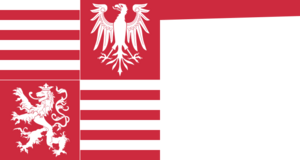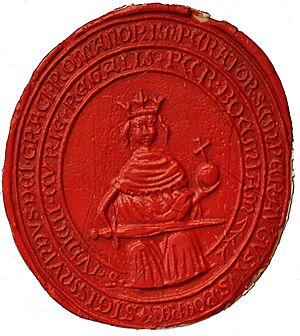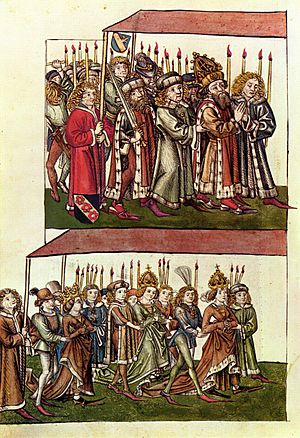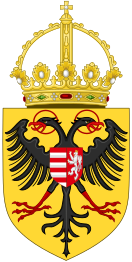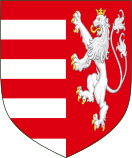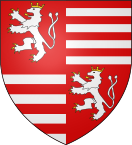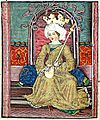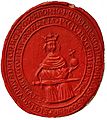Sigismund, Holy Roman Emperor facts for kids
Quick facts for kids Sigismund |
|
|---|---|
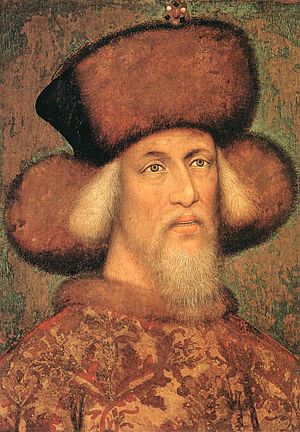
Portrait of Sigismund of Luxemburg attributed to Pisanello, c. 1433
|
|
| King of Hungary and Croatia with Mary (1387–1395 jure uxoris) |
|
| Reign | 1387–1437 |
| Coronation | 31 March 1387 in Székesfehérvár |
| Predecessor | Mary I |
| Successor | Albert |
| King of Germany contested by Jobst (1410–1411) |
|
| Reign | 1410–1437 |
| Coronation | 8 November 1414 in Aachen |
| Predecessor | Rupert |
| Successor | Albert II |
| King of Bohemia | |
| Reign | 1419–1437 |
| Coronation | 27 July 1420 in Prague |
| Predecessor | Wenceslaus IV |
| Successor | Albert |
| Holy Roman Emperor | |
| Reign | 1433–1437 |
| Coronation | 31 May 1433 in Rome |
| Predecessor | Charles IV |
| Successor | Frederick III |
| Born | 15 February 1368 Nuremberg, Kingdom of Germany |
| Died | 9 December 1437 (aged 69) Znojmo, Kingdom of Bohemia |
| Burial | Nagyvárad, Kingdom of Hungary (today Oradea, Romania) |
| Spouse | |
| Issue | Elizabeth of Luxembourg |
| House | Luxembourg |
| Father | Charles IV, Holy Roman Emperor |
| Mother | Elizabeth of Pomerania |
| Religion | Roman Catholicism |
Sigismund of Luxembourg (born February 15, 1368 – died December 9, 1437) was a powerful ruler in Europe during the Middle Ages. He was the King of Hungary and Croatia from 1387. Later, he also became King of Germany in 1410, King of Bohemia in 1419, and finally the Holy Roman Emperor from 1433 until his death. He was also a prince-elector of Brandenburg. Sigismund was the last male ruler from the House of Luxembourg.
Sigismund was the son of Holy Roman Emperor Charles IV. He married Queen Mary of Hungary in 1385 and became King of Hungary. In 1396, he led a big army in the Crusade of Nicopolis, but they were defeated by the Ottoman Empire. After this, he created the Order of the Dragon to fight against the Turks.
Sigismund played a key role in the Council of Constance (1414–1418), which helped end a big split in the Christian Church called the Papal Schism. However, this council also led to the Hussite Wars, which were a major challenge for him later in life. In 1433, he was crowned Holy Roman Emperor.
Historians say that Sigismund had a great vision for his empire and the Church. He wanted to make important changes, but faced many problems. Even so, his time as ruler saw important cultural developments.
Contents
Sigismund's Early Life
Sigismund was born in Nuremberg or Prague. His father was Charles IV, Holy Roman Emperor, and his mother was Elizabeth of Pomerania. He was named after Saint Sigismund of Burgundy. Because of his red hair, people in Bohemia nicknamed him the "ginger fox."

When Sigismund was six, he was promised in marriage to Mary, the daughter of King Louis the Great of Hungary and Poland. This marriage was planned to increase the lands controlled by the House of Luxembourg. After his father died in 1378, Sigismund became the Margrave of Brandenburg. He moved to the Hungarian court, where he quickly learned the Hungarian language and way of life. King Louis even named him as his heir to the Hungarian throne.
In 1381, Sigismund, then 13, was sent to Kraków by his half-brother Wenceslaus, who was King of Germany and Bohemia. Sigismund was meant to learn Polish and get to know the country. He was also given Neumark to help connect Brandenburg and Poland.
While Mary became Queen of Hungary, Sigismund also wanted to be King of Poland. But the Polish people did not want a German ruler or to be tied to Hungary. Instead, they chose Mary's younger sister Jadwiga to be their queen. Jadwiga then married Jogaila of Lithuania.
Becoming King of Hungary
After Mary's father died in 1382, Mary became Queen of Hungary. Sigismund married her in 1385. The next year, he was accepted as her future co-ruler. However, in 1387, Mary and her mother, Elizabeth of Bosnia, were captured by rebellious nobles. Sigismund's mother-in-law was killed, but Mary was freed.
With the support of the nobles, Sigismund was crowned King of Hungary on March 31, 1387. He had to give up Brandenburg to his cousin Jobst to raise money. For the next nine years, he fought to keep control of his unstable throne. The central government was very weak. Sigismund had to make an alliance with the powerful Czillei-Garai League to stay in power. He had to give away a lot of royal land to get their support. It took many years to bring back strong central rule.
Mary died in 1395 while pregnant, leaving Sigismund as the only ruler of Hungary. To reduce pressure from Hungarian nobles, Sigismund tried to use foreign advisors. This was not popular, and he had to promise to only give land and positions to Hungarian nobles. However, this rule did not apply to Stibor of Stiboricz, who was Sigismund's close friend and advisor. Sigismund was even imprisoned by nobles a few times, but with the help of his allies, he always regained power.
The Nicopolis Crusade
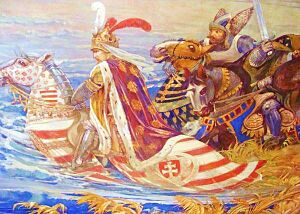
In 1396, Sigismund led a large Christian army against the Ottoman Turks. The Turks had been expanding their control towards the Danube River. This crusade was very popular in Hungary. Many nobles joined, along with volunteers from across Europe, especially from France. Sigismund's army had 90,000 men and 70 ships. After capturing Vidin, they camped near the fortress of Nicopolis.
Sultan Bayezid I arrived with 140,000 men and completely defeated the Christian forces in the Battle of Nicopolis between September 25 and 28, 1396. Sigismund escaped by sea. The defeat at Nicopolis made many Hungarian lords angry, causing more problems in the kingdom.
Returning to Hungary
When Sigismund returned to Hungary in 1401, he was imprisoned and even removed from power twice. That year, he helped an uprising against his half-brother Wenceslaus IV. Wenceslaus was captured, and Sigismund ruled Bohemia for 19 months before releasing him in 1403.
Meanwhile, some Hungarian nobles supported Ladislaus of Naples as king. Ladislaus was a distant relative of the former King Louis I of Hungary. Ladislaus captured Zadar in 1403 but did not advance further. This led to a war with the Republic of Venice, as Ladislaus sold the Dalmatian cities to Venice. Sigismund later worked to stop Ladislaus's plans to conquer central Italy.
Because Sigismund was often away dealing with other countries he ruled, he had to hold meetings with Hungarian nobles more often. He also created the position of Palatine to manage the country when he was gone. In 1404, Sigismund issued a decree called the Placetum Regium. This meant that official Church documents from the Pope could not be used in Hungary without the king's permission. During his long reign, the royal castle of Buda became one of the largest Gothic palaces of the Late Middle Ages.
King of Croatia

Around 1406, Sigismund married Barbara of Celje, who was a cousin of his first wife, Mary. Sigismund managed to gain control in Slavonia. He used strong methods, including a massacre of about 200 noble families in the Battle of Dobor in 1408.
Protecting Southern Borders
To protect Hungary's southern borders from the Ottoman Empire, Sigismund made an alliance with Stefan Lazarević, the ruler of Serbia. In 1403, Stefan received Hungarian lands in northwestern Serbia, including the city of Belgrade. Stefan remained a loyal vassal (a ruler who owes loyalty to a higher king) to Sigismund until his death in 1427. Stefan's successor, George Branković, also swore loyalty to Sigismund and returned Belgrade to him. By keeping good relations with Serbian rulers, Sigismund helped secure his southern borders.
The Order of the Dragon
After his victory at Dobor, Sigismund created his own special group of knights called the Order of the Dragon. The main goal of this order was to fight the Ottoman Empire. Most members were his political allies and supporters, including Nicholas II Garay, Hermann II of Celje, Stibor of Stiboricz, and Pippo Spano. Even important European monarchs became members. Sigismund also helped international trade by removing internal taxes, setting rules for foreign goods, and making weights and measures the same across the country.
Becoming King of the Romans
After King Rupert of Germany died in 1410, Sigismund was chosen as the new king by three electors on September 20, 1410. His cousin Jobst of Moravia was chosen by four other electors on October 1, leading to a conflict. However, Jobst died on January 18, 1411, ending the dispute. Sigismund was then chosen again as king on July 21, 1411. He was crowned on November 8, 1414, in Aachen.
Alliances Against Poland
Sigismund sometimes allied with the Teutonic Knights against Władysław II of Poland. For a large sum of money, he was supposed to attack Poland from the south. Sigismund ordered his friend Stibor of Stiboricz to prepare this attack. Stibor, who was of Polish origin, became very powerful in Europe. He held titles like Duke of Transylvania and owned a large part of modern-day Slovakia.
Sigismund used Stibor's diplomatic skills to gain money. While there were family meetings between Polish and Hungarian negotiators, they could not stop the war. An alliance of 22 western states formed an army against Poland in the Battle of Grunwald in July 1410. Stibor attacked Nowy Sącz and burned it, but then returned to his castle. After Poland and Lithuania won the Battle of Grunwald, the Teutonic Knights had to pay a lot of silver to Poland. Sigismund, through Stibor, was able to borrow this silver from King Władysław II of Poland on good terms.
The Buda Conference
In 1412, a big Knights Tournament and conference took place in Buda, Hungary. King Sigismund of Hungary, King Wladyslaw II of Poland, and King Tvrtko II of Bosnia were present. About 2,000 knights from all over Europe, including England, attended.
The court in Buda was filled with many princes, lords, knights, and servants. There were three kings, a Serbian ruler, 13 dukes, 21 counts, 2,000 knights, a cardinal, a legate, three archbishops, 11 other bishops, and many musicians and messengers. People from 17 different countries and languages were there. The Grand Master of the Teutonic Knights also attended.
The meeting included many celebrations and entertainment. At the tournament, a knight from Silesia and a page from Austria won the jousting competition. A Polish historian, Jan Długosz, wrote that knights from Bulgaria were also at the tournament, likely from the court of Prince Fruzhin, who was Sigismund's vassal.
The Council of Constance
From 1412 to 1423, Sigismund fought against the Republic of Venice in Italy. He used the problems of Antipope John XXIII to get a promise for a big meeting, called the Council of Constance, in 1414. This council was meant to end the Western Schism, a time when there were three rival popes.
Sigismund played a leading role in the council. During its sessions, he traveled to France, England, and Burgundy to try and convince the three popes to step down. The council ended in 1418. It successfully ended the Papal Schism. However, it also led to the burning of the Czech religious reformer, Jan Hus, for heresy in July 1415. Sigismund had given Hus a promise of safe travel and protested his imprisonment, but Hus was burned while Sigismund was away.
Once, during the council, a cardinal corrected Sigismund's Latin. Sigismund famously replied, Ego sum rex Romanus et super grammaticam, which means "I am king of the Romans and above grammar."
During these years, Sigismund also made an alliance with England against France. He tried to bring peace to Germany by forming a league of towns, but this failed because the princes were against it. In 1415, Sigismund gave Brandenburg (which he had gotten back after Jobst's death) to Frederick of Hohenzollern. This made the Hohenzollern family very important in Germany.
Sigismund shifted his alliance from France to England after France's defeat at the Battle of Agincourt. He signed the Treaty of Canterbury with Henry V of England on August 15, 1416. This created an alliance against France and helped resolve the papal split. Sigismund's close relationship with Henry V led to him becoming a member of the Order of the Garter.
The Hussite Wars
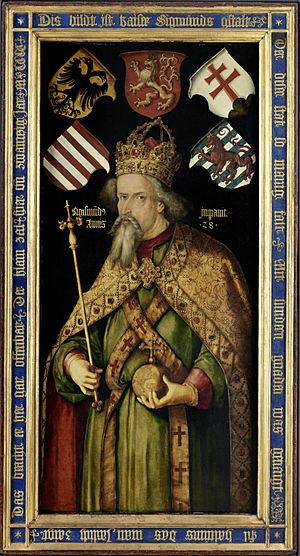
In 1419, Wenceslaus IV died, making Sigismund the official King of Bohemia. However, he had to wait 17 years before the Czech nobles would accept him. While being King of the Romans and Bohemia made him seem more important, it did not give him more power and caused him financial problems. It was only as King of Hungary that he truly had strong authority.
The Bohemians, who did not trust him because of what happened to Hus, soon rebelled. The situation worsened when Sigismund said he would fight against heretics. Three campaigns against the Hussites ended badly for Sigismund. Meanwhile, the Turks were attacking Hungary again.
In 1422, Sigismund and German princes planned two armies against the Hussite rebels. One army was sent to help Karlštejn, which was under siege by Hussites. The second army was ordered to destroy the Hussite army in the field. But Jan Žižka, the Hussite leader, defeated the Imperial forces at the Battle of Kutná Hora and then at the Battle of Deutschbrod. These defeats ended the first attempts to crush the Bohemian rebellion.
However, the alliance against the Hussites continued to grow, with princes and cities from across Germany joining. In 1424, German electors formed the Union of Bingen, promising to help each other against the Hussite threat.
Sigismund's Rule in Germany
Sigismund's rule in Germany was difficult because he lacked strong personal power within the German kingdom. His rule depended on key allies and the way politics worked in Germany at the time. Historians note that Sigismund succeeded when he worked closely with important leaders and groups. Even when he was away from Germany, he could rely on these partnerships. For example, these alliances led to large-scale actions against Duke Friedrich of Austria-Tyrol and the Hussites.
The alliance between Sigismund and his two main allies in Germany, Frederick I, Elector of Brandenburg and Albert of Habsburg, was very important. Albert married Sigismund's only daughter, Elizabeth of Luxembourg, becoming his heir. This alliance helped the Hohenzollern family rise to power and brought the Habsburgs back to the German throne. The Habsburgs also inherited the connections with Hungary, Croatia, and Bohemia from Sigismund.
Final Years and Death
In 1428, Sigismund led another campaign against the Turks, but again with little success. In 1431, he went to Milan, where he received the Iron Crown as King of Italy. He then stayed in Siena, working to be crowned emperor and to get Pope Eugenius IV to recognize the Council of Basel.
He was crowned emperor in Rome on May 31, 1433. After getting his demands from the Pope, he returned to Bohemia. He was finally recognized as king there in 1436, though his power was mostly just in name. Shortly after his coronation, Pope Eugenius tried to create a new alliance against the Ottomans, sparked by an Albanian revolt that began in 1432. Sigismund sent a Bulgarian nobleman, Fruzhin, to negotiate with the Albanians in 1435. However, after the rebels were defeated in 1436, plans for an anti-Ottoman alliance ended.
Sigismund died on December 9, 1437, in Znojmo (Znaim), Moravia (now in the Czech Republic). As he wished, he was buried in Nagyvárad, Hungary (today Oradea, Romania), next to the tomb of Saint Ladislaus I of Hungary. Saint Ladislaus was seen as the perfect monarch and Christian warrior at that time, and Sigismund greatly admired him.
With his second wife, Barbara of Celje, Sigismund had only one daughter, Elisabeth of Luxembourg. She married Albert V, Duke of Austria (who later became German king as Albert II), whom Sigismund named as his successor. Since Sigismund had no sons, his line of the House of Luxembourg ended when he died.
Family and Children
Sigismund married twice but had difficulty securing heirs to his crowns. Each of his two marriages resulted in the birth of one child. His first child, likely a son, was born too early after Queen Mary of Hungary had a horse riding accident in 1395. Both Mary and the baby died shortly after the birth. This caused a big problem for who would rule next, because Sigismund ruled Hungary through his wife. Although he managed to keep his power, the problem lasted until his second marriage to Barbara of Celje.
Barbara's only child, Elisabeth of Luxembourg, was born on October 7, 1409, probably in Visegrád castle. Elisabeth later became queen of Hungary, Germany, and Bohemia. Queen Barbara did not have any more children. So, Elisabeth was Sigismund's only surviving child.
Hungarian Connections
Sigismund was known to speak Hungarian fluently. He also wore Hungarian-style royal clothes and grew his beard in the Hungarian fashion. He spent a lot of money to rebuild the Gothic castles of Buda and Visegrád in Hungary, bringing materials from Austria and Bohemia.
Many stories and legends grew around Sigismund. One legend, told decades later during the reign of King Matthias Corvinus of Hungary, claimed that John Hunyadi was Sigismund's son. The story says Sigismund gave a ring to the boy's mother when he was born. One day, a raven stole the ring, but it was recovered after the bird was hunted. This event is said to have inspired the Hunyadi family's coat of arms, which later appeared in Matthias "Corvinus"'s coat of arms.
Sigismund admired Saint Ladislaus I of Hungary, who was considered an ideal Christian knight. Sigismund visited his tomb in Nagyvárad several times. Before he died, Sigismund asked to be buried next to the saint king.
Sigismund's family line connects to the royal Hungarian Árpád dynasty through three princesses.
| Béla III of Hungary |
|||||||||||||||||||||||||||||
| Andrew II of Hungary |
Constance of Hungary | ||||||||||||||||||||||||||||
| Béla IV of Hungary |
|||||||||||||||||||||||||||||
| Yolanda of Hungary | Anna of Hungary | Wenceslaus I of Bohemia | |||||||||||||||||||||||||||
| Jadwiga of Kalisz | Kunigunda of Halych | Ottokar II of Bohemia | |||||||||||||||||||||||||||
| Casimir III of Poland | Wenceslaus II of Bohemia | ||||||||||||||||||||||||||||
| Elizabeth of Poland | Elizabeth of Bohemia | ||||||||||||||||||||||||||||
| Elizabeth of Pomerania | Charles IV, Holy Roman Emperor | ||||||||||||||||||||||||||||
| Sigismund, King of Hungary and Holy Roman Emperor |
|||||||||||||||||||||||||||||
Titles Held by Sigismund
Sigismund held many important titles. He was:
- Elected Holy Roman Emperor
- King in Germany
- King of Hungary
- King of Bohemia
- King of Italy
- King of Dalmatia
- King of Croatia
- King of Rama
- King of Serbia
- King of Galicia
- King of Lodomeria
- King of Cumania
- King of Bulgaria
- Duke of Silesia
- Duke of Luxembourg
- Margrave of Moravia
- Margrave of Lusatia
- Margrave of Brandenburg
Heraldry and Symbols
| Heraldry of Sigismund, Holy Roman Emperor | ||||||||||
|---|---|---|---|---|---|---|---|---|---|---|
|
||||||||||
See also
 In Spanish: Segismundo de Luxemburgo para niños
In Spanish: Segismundo de Luxemburgo para niños
- Kings of Germany family tree
- Stibor of Stiboricz
- Clan of Ostoja
- Order of the Dragon
Images for kids
-
Sigismund's first wife, Queen Mary of Hungary.
-
King Sigismund of Hungary during the battle of Nicopolis in 1396. Painting by Ferenc Lohr (1896), main hall of the Castle of Vaja.
-
Drinking horn of Sigismund of Luxembourg, before 1408.
-
Portrait of Emperor Sigismund, painted by Albrecht Dürer after the emperor's death.



